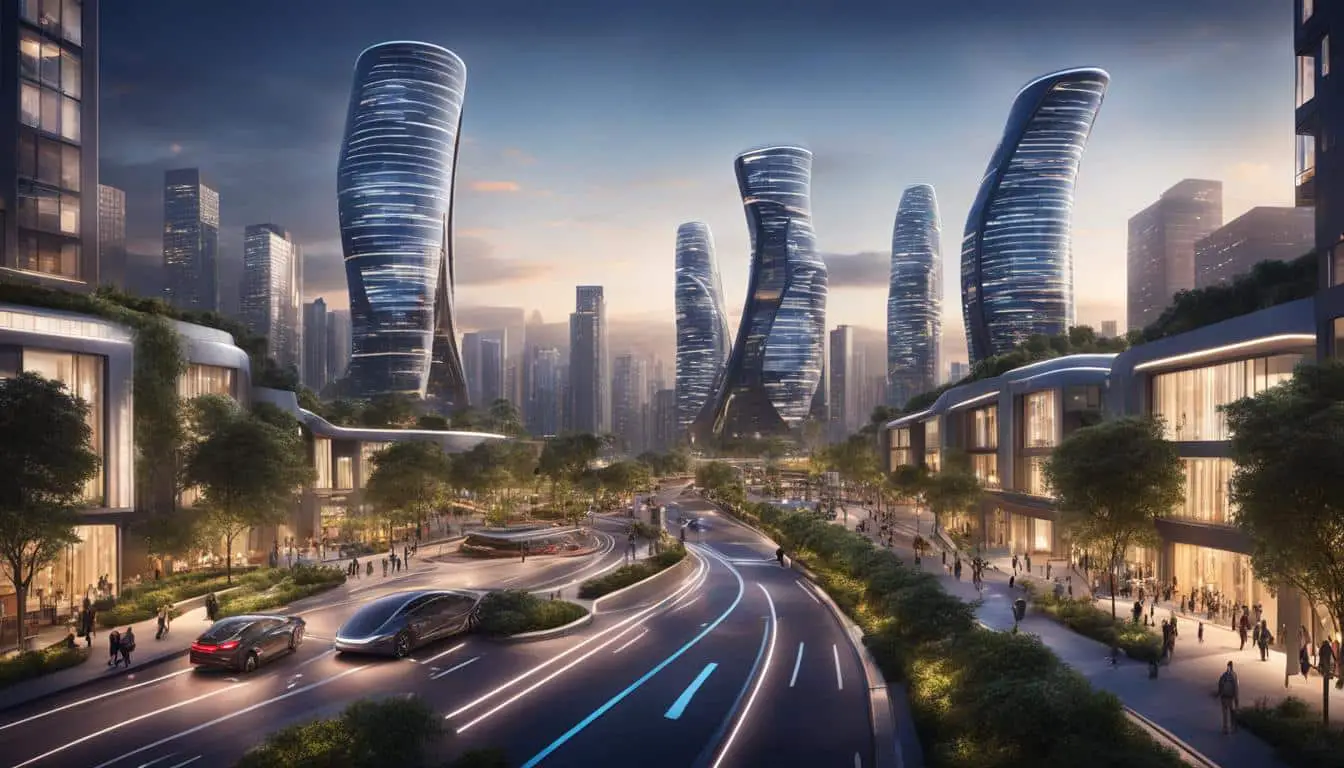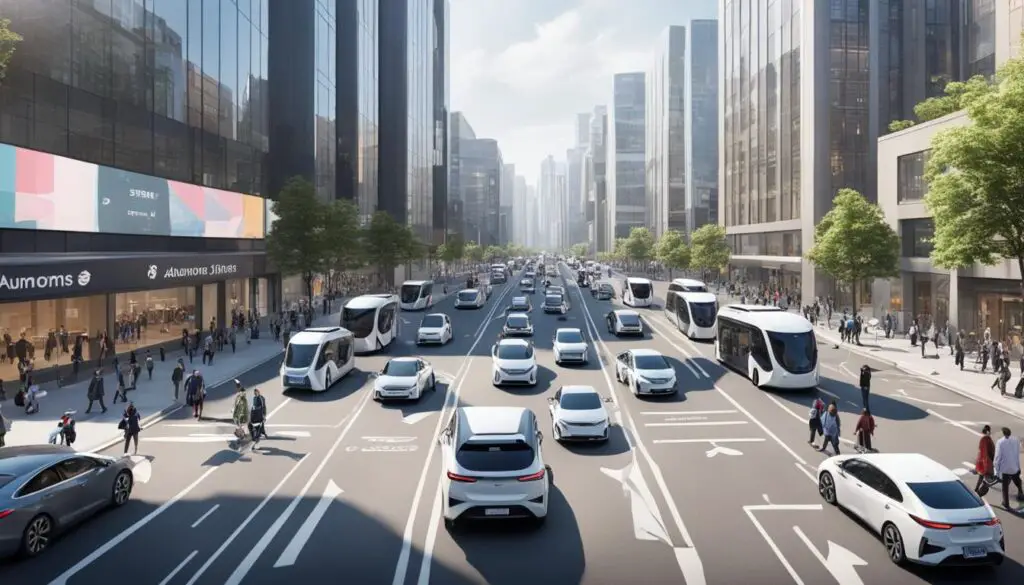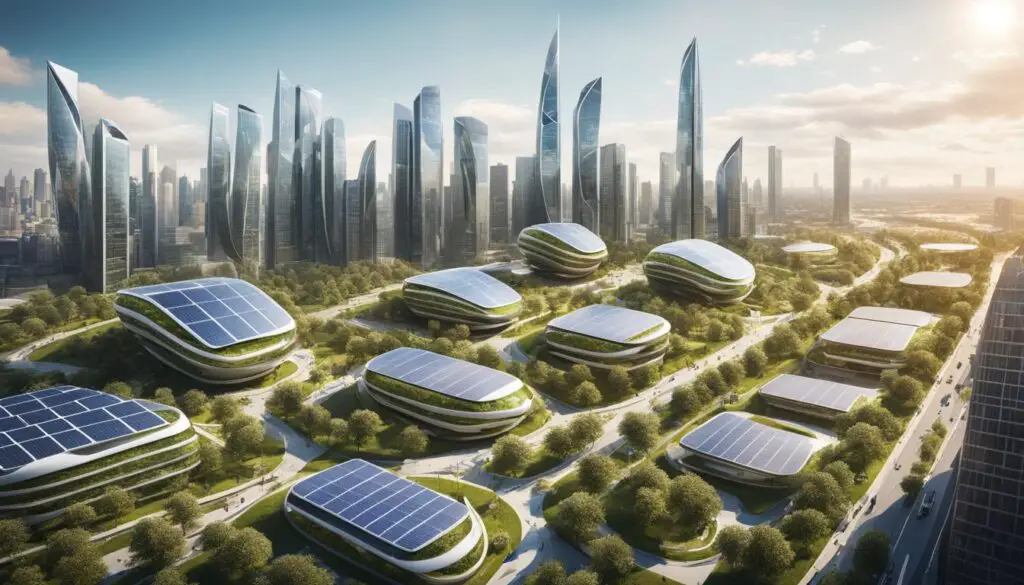
Designing Urban Landscapes for Autonomous Vehicles
As we look towards the future, the rise of self-driving cars is poised to have a profound impact on our urban landscapes. The integration of autonomous vehicles has the potential to reshape city infrastructures, addressing pressing issues such as traffic congestion, environmental pollution, and inefficient transportation systems.
With the increasing urbanization of cities, finding sustainable solutions to these challenges is crucial. Self-driving cars offer a promising path forward, providing opportunities for smart city solutions that can transform our urban environments. In this article, we will explore the various ways in which autonomous vehicles will affect urban landscapes and discuss the possibilities they bring for the future.
Key Takeaways:
- Self-driving cars have the potential to reshape city infrastructures and address urban challenges.
- Autonomous vehicles offer smart city solutions that can alleviate traffic congestion and environmental pollution.
- The integration of self-driving cars into urban planning can create more efficient and sustainable cities.
- Designing urban landscapes for autonomous vehicles involves repurposing road space and transforming parking lots.
- Autonomous vehicles contribute to sustainability efforts by reducing emissions and improving energy efficiency.
The Implications of Autonomous Vehicles on Urbanism and Mobility
The impact of autonomous vehicle (AV) technology on urbanism and mobility is a topic of much discussion. While there may be misconceptions about what AV technology means for the future of urban life, it is clear that significant changes will occur. A research team at Sasaki focused on the implications of AV technology on urban fabric and mobility. They analyzed a particular stretch of Somerville Avenue in Somerville, MA, to understand how AVs will interact with the urban environment.
The team identified five key decisions that will need to be considered:
- The social and public health impacts of AV technology
- Ownership models for AVs
- Integration with bikes, pedestrians, and transit
- Reclaiming the public realm
- The effect on development and land use
“The integration of AV technology within urban environments presents the opportunity to reimagine the way we plan and design cities. By understanding and addressing the implications of AVs on various aspects of urban life, we can create more sustainable, efficient, and inclusive communities.”
As AV technology continues to advance, it is crucial to consider the impact on the urban fabric and mobility patterns. The widespread changes that AVs bring will have far-reaching effects on middle neighborhoods and beyond. From the social and public health challenges to redefining land use and development, the implications of AVs on urbanism and mobility require careful consideration and planning.
Case Study: Somerville Avenue, Somerville, MA
To gain a deeper understanding of how AVs will interact with the urban fabric, the research team analyzed Somerville Avenue in Somerville, MA. This specific location served as a microcosm for studying the potential changes and impacts of AV technology on urban mobility. By focusing on a real-world scenario, the team was able to identify key considerations and decision points that will shape the future landscape.
The case study revealed that the integration of AVs will necessitate thoughtful planning and design interventions to ensure seamless integration with existing infrastructure and modes of transportation. The implications go beyond just the physical layout, impacting social dynamics and development opportunities in urban environments.
| Key Decisions | Description |
|---|---|
| Social and Public Health Impacts | Understanding how AV technology will influence social behaviors, public health, and accessibility. |
| Ownership Models | Exploring different ownership models for AVs, including private ownership, shared ownership, and fleet-based services. |
| Integration with Bikes, Pedestrians, and Transit | Developing strategies to integrate AVs seamlessly with existing modes of transportation, prioritizing safety and efficiency. |
| Reclaiming the Public Realm | Reevaluating the allocation of public space to create more pedestrian-friendly environments and enhance quality of life. |
| Effect on Development and Land Use | Examining how AVs will influence development patterns, land use decisions, and the utilization of urban space. |
Rethinking Urban Design for Shared Autonomous Vehicles
One of the most promising impacts of autonomous vehicles is their potential to reduce private vehicle ownership and alleviate congestion. As more people turn to shared autonomous rides, there will likely be a decrease in the number of cars on the streets, leading to cleaner and more livable cities. Shared autonomous vehicles also have the potential to improve safety and increase access to transportation for disadvantaged communities. This shift in transportation patterns calls for a rethinking of urban design to accommodate shared autonomous vehicles and optimize their efficiency and impact on the urban landscape.
The integration of shared autonomous vehicles into urban design requires a multi-faceted approach. Cities must consider factors such as efficient pick-up and drop-off points, dedicated lanes for autonomous vehicles, and smart traffic management systems. By prioritizing the needs of shared autonomous vehicles, cities can maximize the benefits of reduced private vehicle ownership and alleviated congestion.
One of the key considerations in rethinking urban design for shared autonomous vehicles is the allocation of road space. With a decrease in private vehicle ownership, cities can repurpose roadways to create more accessible public spaces, pedestrian-friendly zones, and dedicated bike lanes. This transformation can enhance the overall livability of urban areas and promote sustainable modes of transportation.
Benefits of Rethinking Urban Design for Shared Autonomous Vehicles
The rethinking of urban design to accommodate shared autonomous vehicles offers several benefits:
- Reduced Private Vehicle Ownership: Shared autonomous vehicles encourage individuals to rely less on private cars, leading to fewer vehicles on the road and reduced congestion.
- Alleviated Congestion: By optimizing the pick-up and drop-off points and leveraging advanced traffic management systems, cities can minimize congestion and improve traffic flow.
- Improved Safety: Shared autonomous vehicles are equipped with advanced safety features and technologies, such as collision avoidance systems and real-time monitoring. This enhancement in safety standards can significantly reduce traffic accidents and improve pedestrian safety.
- Inclusive Transportation: Shared autonomous vehicles provide increased access to transportation for disadvantaged communities, enhancing mobility options and ensuring equitable transportation opportunities for all.
As cities embrace the era of shared autonomous vehicles, urban design must evolve to harness the full potential of this transformative technology. By integrating shared autonomous vehicles into the fabric of urban planning, cities can create sustainable, efficient, and people-centric environments.
In the words of renowned urban planner Jane Jacobs, “Cities have the capability of providing something for everybody, only because, and only when, they are created by everybody.”
Comparative Analysis of Private Vehicle Ownership and Shared Autonomous Vehicle Adoption
| Metrics | Private Vehicle Ownership | Shared Autonomous Vehicle Adoption |
|---|---|---|
| Number of Cars on the Road | High | Low |
| Congestion Levels | High | Low |
| Safety | Varied | Improved |
| Accessibility | Varied | Inclusive |

Transforming Urban Landscapes with Autonomous Vehicles
The widespread adoption of autonomous vehicles presents a unique opportunity to transform urban landscapes and reimagine traditional urban planning. As self-driving cars utilize road networks more efficiently, valuable land that is currently dedicated to roadways can be repurposed for other purposes, such as creating green spaces, walkways, or dedicated bike lanes. This efficient use of road space not only enhances the aesthetic appeal of the city but also promotes sustainable transportation options.
Furthermore, the reduced need for parking in high-demand urban areas opens up exciting possibilities for repurposing parking lots and transforming them into vibrant and productive spaces. These areas can be transformed into public parks, community gardens, or innovative urban developments, fostering a sense of community and promoting social interaction.
To fully optimize the benefits of autonomous vehicles in urban environments, buildings and streets need to adapt to accommodate autonomous traffic. Efficient drop-off and pickup points can be strategically integrated into building designs, ensuring a seamless flow of vehicles and passengers. This adaptation will contribute to the overall efficiency of the transportation system, reducing traffic congestion, and improving the overall urban experience.
As autonomous vehicles transition to electric-powered alternatives, the need for traditional fuel stations will diminish. This shift opens up opportunities to redefine fuel stations and repurpose them for alternative uses that align with the changing needs of urban environments. These spaces can be transformed into charging stations for electric vehicles, mini markets, or community spaces.
By embracing the transformative potential of autonomous vehicles, cities can unlock new possibilities for urban design, creating sustainable and livable urban landscapes that prioritize efficient use of resources, promote alternative modes of transportation, and foster a vibrant and connected community.
The Benefits of Transforming Urban Landscapes:
| Benefits | Description |
|---|---|
| Efficient use of road space | Repurposing roadways for green spaces, walkways, and dedicated bike lanes. |
| Revitalized parking lots | Transforming parking lots into vibrant and productive spaces. |
| Adaptation of buildings | Efficient drop-off and pickup points integrated into building designs. |
| Redefining fuel stations | Exploring alternative uses for traditional fuel stations. |
The Impact of Autonomous Vehicles on Sustainability
Self-driving cars have emerged as a transformative force in sustainability efforts. The inherent efficiency of autonomous vehicles leads to reduced fuel consumption and lower greenhouse gas emissions. With the potential to decrease private vehicle ownership and increase shared rides, there will be fewer cars on the road, resulting in reduced pollution.
Additionally, advancements in autonomous car technology lead to weight reduction, which further contributes to energy efficiency. The enhanced safety features of autonomous vehicles also play a role in sustainability by reducing accidents and saving lives.

The reduced emissions, efficiency in operation, and weight reduction of autonomous vehicles contribute to a more eco-friendly transportation system. By embracing self-driving cars, we can work towards a future with cleaner air and improved sustainability.
| Benefit | Description |
|---|---|
| Reduced Emissions | Autonomous vehicles consume less fuel, leading to lower greenhouse gas emissions and improved air quality. |
| Efficiency in Operation | Self-driving cars optimize routes and minimize congestion, resulting in smoother traffic flow and reduced energy waste. |
| Fewer Cars on the Road | Increased adoption of shared autonomous rides reduces the number of individual vehicles on the road, leading to reduced pollution and traffic congestion. |
| Weight Reduction | Advancements in autonomous car technology allow for lighter vehicle designs, which improve energy efficiency and reduce environmental impact. |
| Enhanced Safety | Autonomous vehicles are equipped with advanced safety features, reducing the likelihood of accidents and promoting safer roads. |
By harnessing the benefits of autonomous vehicles, we can pave the way for a more sustainable future. Not only do self-driving cars offer the potential to reduce emissions and improve energy efficiency, but they also enhance safety and contribute to a cleaner, greener environment.
Conclusion
Self-driving cars are poised to revolutionize urban landscapes and transform the way cities operate in the future. With their integration into urban planning, there is immense potential to create more efficient, sustainable, and livable cities. The impact of autonomous vehicles on urban landscapes will be far-reaching, touching upon various aspects of city infrastructure.
One of the key implications of self-driving cars is the opportunity to repurpose road space, freeing up valuable land for other purposes. This includes the transformation of parking lots into vibrant spaces that cater to the needs of the community. As autonomous vehicles become the norm, buildings and streets will need to adapt, featuring efficient drop-off and pickup points to optimize traffic flow.
Moreover, the transition to self-driving cars presents an opportunity to redefine traditional fuel stations and support the shift towards sustainable transportation. With the majority of autonomous vehicles being electric, the need for traditional fuel stations will diminish, making way for alternative uses of these spaces, such as charging stations or community hubs.
By embracing the potential of self-driving cars and designing urban environments that prioritize sustainability, we can build a future where transportation is efficient, emissions are reduced, and cities are more livable. As we navigate the path towards self-driving cars, it is crucial to consider the collective benefits they bring, shaping urban landscapes for a better and more sustainable future.
FAQ
What is the impact of autonomous vehicles on urban landscapes?
Autonomous vehicles have the potential to significantly reshape urban landscapes by optimizing road usage, repurposing valuable land currently dedicated to roadways, and transforming parking lots into vibrant spaces.
How do self-driving cars affect private vehicle ownership?
Self-driving cars have the potential to reduce private vehicle ownership as more people turn to shared autonomous rides, leading to cleaner and more livable cities.
What are the benefits of shared autonomous vehicles?
Shared autonomous vehicles not only reduce congestion and improve safety but also increase access to transportation for disadvantaged communities.
How can urban design be rethought to accommodate autonomous vehicles?
Urban design needs to prioritize efficient drop-off and pickup points for autonomous vehicles and consider the integration of bike lanes, pedestrian pathways, and public transit.
In what ways can autonomous vehicles contribute to sustainability?
Autonomous vehicles can contribute to sustainability by reducing fuel consumption, lowering greenhouse gas emissions, and decreasing the number of cars on the road.
How do autonomous vehicles enhance safety?
Autonomous vehicles come with advanced safety features that reduce accidents and save lives, making them an integral part of sustainable transportation efforts.
